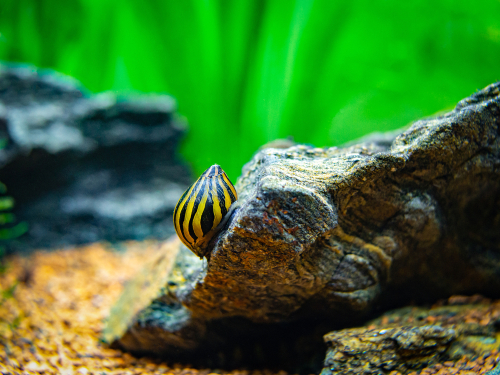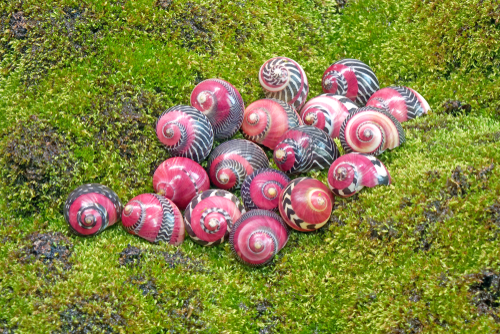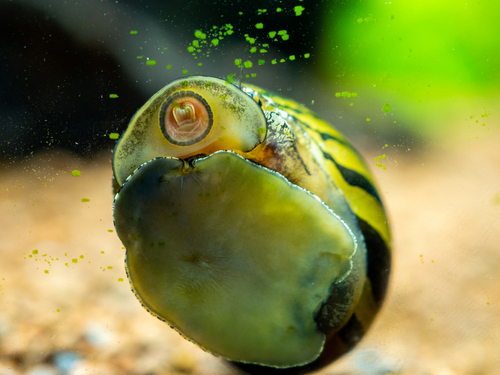Meet the Nerite snails, the unsung heroes of the aquarium world. These tiny, peaceful creatures are a favorite among aquarium enthusiasts. Hailing from the Neritidae family, Nerite snails thrive in fresh and saltwater environments.
They’re often spotted in coastal areas, especially around Africa and the Indo-Pacific region, and grow to a modest size of 0.5-1.5 inches.
But what makes Nerite snails stand out is their unrivaled ability to keep your aquarium spotless. They’re nature’s little janitors, with a voracious appetite for algae.
This makes them the perfect tank-mates for other aquatic animals like dwarf shrimp, as they help maintain a clean and healthy environment for all.
And the best part? Unlike other ordinary aquarium snails, Nerite snails won’t overrun your tank. They’re known for their inability to reproduce in freshwater, ensuring that your aquarium remains balanced and under control.
So, if you’re looking for a low-maintenance, high-impact addition to your aquarium, Nerite Snails are the perfect fit!
Contents
Basic Information

Essential Facts
Nerite snails are a fantastic addition to any aquarium, thanks to their algae-eating prowess and their striking appearance. As members of the Neritidae family, these snails come in a variety of species, with the most common ones in aquariums belonging to the Nerita, Theodoxus, or Neritina genera.
These petite to medium-sized snails are incredibly adaptable, capable of thriving in freshwater, brackish water, and saltwater environments. They hail from tropical and subtropical regions worldwide, and their hardy nature allows them to adjust to a wide range of water conditions.
Ideally, the water’s pH for nerite snails should be between 6.5 and 8.5, and the general hardness (GH) should be maintained between 5-15 dGH.
One of the standout features of nerite snails is their distinctive shell patterns. From the Zebra Nerite’s bold stripes to the Horned Nerite’s unique protrusions, these snails add a touch of visual intrigue to any aquarium.
But it’s not just their looks that make nerite snails a favorite among aquarium enthusiasts. These snails are algae-eating machines, helping to keep your tank clean and healthy.
They’re known for their peaceful nature, making them a perfect fit for community tanks. So, if you’re looking for a low-maintenance, high-impact addition to your aquarium, nerite snails are a fantastic choice.
Types of Nerite Snails
This section explores various types of nerite snails commonly found in aquariums. These fascinating creatures come in different patterns and colors, enriching the visual appeal of your freshwater tank.
1. Zebra Nerite Snail

The Zebra Nerite Snail (Neritina natalensis Zebra) is a widespread species known for its attractive black-and-white striped shell. These snails are excellent algae eaters and help keep aquariums clean. They are relatively small, making them a perfect fit for various tank sizes.
2. Tiger Nerite Snail
Another exciting type of nerite snail is the Tiger Nerite Snail (Neritina turrita). Their shell features bold, dark stripes resembling a tiger’s pattern, hence the name. Like the Zebra Nerite Snail, they contribute towards maintaining a clean and healthy aquarium environment by consuming algae.
3. Horned Nerite Snail

The Horned Nerite Snail (Neritina Clithon corona) is a unique species due to the small horn-like projections on their shell. They come in various colors and patterns, including yellow and black stripes or spotted designs. These snails play a vital role in controlling algae growth in the tank.
4. Olive Nerite Snail
The Olive Nerite Snail (Neritina reclivata) boasts an eye-catching olive-green shell with dark, irregular markings. This variety is also known for its algae-eating capabilities, which help maintain a well-balanced aquarium.
5. Black Racer Nerite Snail
The Black Racer Nerite Snail (Neritina pulligera) features a dark brown shell with alternating pale and dark bands across each spiral. They prefer to inhabit brackish waters or still wetlands, including marshes, ponds, streams, and rivers.
In aquariums, they offer the benefit of algae control and diversify the aquatic landscape.
6. Red Racer Nerite Snail

Lastly, the Red Racer Nerite Snail (Vittina waigiensis), also known as the Gold Racer Nerite Snail, is a vibrant addition to any aquarium. This colorful snail stands out for its bright red shell adorned with gold and black patterns.
As with other nerite snails, they contribute to a clean and healthy aquatic environment by consuming algae2.
Natural Habitat
Nerite snails have a unique natural habitat that spans various regions and environments. Originally native to Africa, specifically Kenya, Tanzania, and Mozambique, they have expanded their habitats and can now be found along the Pacific and Atlantic coastlines, thriving in both fresh and saltwater environments.
These adaptable snails are commonly found in delta areas, such as mangroves and estuaries, where freshwater sources merge with the ocean. In these areas, they take advantage of the abundant vegetation and algae, which serve as their primary food source.
In their African origin, Nerite snails inhabit a mix of saltwater from the sea and freshwater from rivers. Saltwater varieties of nerite snails can be found on the Caribbean or Pacific coast, demonstrating their adaptability to different water conditions.
Despite these wide-ranging habitats, Nerite snails do not tolerate extreme conditions, requiring stable water parameters to thrive in their environments.
Throughout their natural habitats, Nerite snails play an essential role in maintaining the balance of their ecosystems. As efficient algae eaters, they contribute to keeping water bodies clean and clear, benefiting both aquatic plants and fellow inhabitants.
Physical Appearance
Nerite snails exhibit a variety of fascinating features that make them a popular choice for aquarium enthusiasts. These tiny creatures usually measure less than 1 inch in length, making them an unobtrusive addition to most tanks.
In terms of color, they display a wide range of shades, with some species boasting hues as vibrant as red, while others remain more subdued, sporting earthy tones like olive green.
Patterns on their shells can consist of stripes, spots, or more intricate designs, adding aesthetic appeal and a touch of natural beauty to any tank. Specifically, zebra nerite snails are known for their striking stripes, which create a bold and eye-catching visual effect.
Horned nerite snails, on the other hand, possess small spikes on their shells, giving them a distinctive, rugged appearance. Another variety, the tiger nerite snail, features a unique pattern that resembles the markings of its namesake, the majestic tiger.
It’s important to note that nerite snails are not only diverse in appearance; their coloration and pattern can also vary among individuals within the same species. This wide array of physical traits allows hobbyists to choose snails that best complement the visual aesthetic of their aquariums.
Keeping Nerite Snails

Nerite snails, belonging to the Neritidae family, are a versatile and beneficial addition to a freshwater tank due to their cleaning abilities. It is important to provide them with appropriate living conditions to ensure their health and longevity.
To begin, choose the right substrate for your tank, such as sand or fine gravel. Adding driftwood, rocks, and other decorations will offer ample hiding spots and grazing surfaces for these tiny invertebrates, which grow to be less than 1 inch in size. A tank size of at least 10 gallons is recommended to comfortably accommodate a small group of nerite snails.
Water parameters play a significant role in the health of nerite snails. The ideal water temperature for these snails falls within the range of 72-78°F (22-26°C), while water hardness should be maintained between 6-12 dKH. The pH level should be kept between 7.0 and 8.0, providing a stable and slightly alkaline environment for the snails.
Regular monitoring of ammonia, nitrate, and nitrite levels is essential to prevent harmful spikes that may affect the health of your nerite snails. Establishing a good population of beneficial bacteria in the tank will aid in maintaining essential water parameters and minimize fluctuations.
Feeding and Diet
Nerite snails are primarily herbivores known for their ability to consume various forms of algae. They are beneficial to aquariums since they help keep the aquatic environment clean and healthy.
In an aquarium setting, nerite snails will feed on naturally occurring algae growing on surfaces like glass, decorations, and plants. Supplementary food sources can be introduced to provide these snails with proper nutrients.
In addition to algae, a well-rounded nerite snail diet should include other food sources. Some common options include:
- Algae wafers: These sinking wafers provide a great algae-based food source and are easily available in pet stores
- Blanched vegetables: Softened vegetables such as zucchini, cucumber, and spinach can be fed to nerite snails
- Calcium-rich foods: Cuttlebone and certain commercial pellets can provide essential calcium for the healthy shell growth of nerite snails.
It’s important to provide nerite snails with a balanced and nutritious diet, as it supports their overall growth and well-being. A diverse diet ensures that these invertebrates remain healthy, active, and efficient in controlling algae within a planted aquarium.
Furthermore, proper feeding practices can help prevent potential water quality issues caused by an overgrowth of algae.
When feeding nerite snails, offering a small amount of food daily is best, allowing them to graze throughout the day. This will help maintain a natural feeding pattern while preventing overfeeding.
Take care to remove uneaten vegetables after 24 hours to avoid fouling the water in the aquarium and creating a breeding ground for harmful bacteria.
Behavior and Temperament

Nerite snails are known for their peaceful and calm temperament, making them a great addition to any freshwater aquarium. They are not aggressive and can coexist with most other invertebrates and small fish without issues. Their behavior in a tank typically revolves around their relentless pursuit of algae and other organic matter to consume.
As members of the Neritidae family, these snails prefer living in groups. When left on their own, nerite snails might not be as happy or active as they would be in the company of others.
It is not uncommon to see them working together as they clean the surfaces of the aquarium, making the environment healthier and more pleasant for all inhabitants.
One important aspect of their behavior to keep in mind is their innate ability to escape. As excellent climbers, they are known to sometimes crawl out of the tank if the water conditions are not ideal.
Providing a healthy environment with proper water parameters and a secure lid on your aquarium can help prevent these great escapes.
Tank Mates
Nerite snails are peaceful aquarium inhabitants, making them great additions to a variety of community tanks. When selecting tank mates for nerite snails, it is important to choose other peaceful and non-aggressive species. Some suitable tank mates include:
- Rasboras: Small schooling fish, rasboras are known for their peaceful temperament and compatibility with nerite snails. They come in various colors and patterns for a visually appealing aquarium.
- Neon Tetras: These small, colorful fish are another excellent choice for a community tank with nerite snails. Neon tetras are non-aggressive and coexist well with invertebrates like snails.
- Honey Gourami: A type of small, peaceful fish, honey gourami makes good tank mates for nerite snails. They are unlikely to bother the snails and are visually attractive with their vibrant colors.
- Corydoras: As bottom-dwelling fish, corydoras can share the tank with nerite snails without getting in each other’s way. They are peaceful scavengers that contribute to keeping the tank clean.
In addition to these fish, nerite snails can also live harmoniously with certain invertebrate species. Potential invertebrate companions include:

- Red Cherry Shrimp: These colorful shrimp are non-aggressive and share the same diet as nerite snails, both feeding on algae and biofilm. They can coexist peacefully without competing for resources.
- Ghost Shrimp: Similar to red cherry shrimp, ghost shrimp are another non-aggressive option for a mixed invertebrate tank. They also feed on algae and biofilm, making them compatible with nerite snails.
- Blue Velvet Shrimp: With their stunning blue color, blue velvet shrimp are an eye-catching addition to any community tank. They are also non-aggressive and feed on the same diet as nerite snails, allowing for a harmonious tank environment.
It is essential to avoid aggressive fish species, such as bettas or tiger barbs, which may attack or stress nerite snails. By selecting compatible tank mates, you can create a serene, visually appealing aquarium for your nerite snails and their aquatic friends.
Breeding and Reproduction
Nerite snails are a popular choice for aquarium enthusiasts due to their low maintenance requirements and beneficial impact on the tank’s ecosystem. They are especially helpful in maintaining healthy plants, as they feed on algae and prevent overgrowth.
Breeding nerite snails can be a bit challenging, as they require specific conditions for reproduction. Unlike other snails, nerite snails are not hermaphroditic; they have separate male and female sexes.
However, determining the sex of a Nerite snail is quite tricky since they display almost no sexual dimorphism. One way to identify their sex is to observe their mating behavior, as the male is usually on top.
It is essential to note that nerite snails do not reproduce in freshwater aquariums. They need brackish water (a mixture of freshwater and saltwater) to lay their eggs.
However, even in freshwater tanks, female nerite snails may lay many small white eggs on surfaces such as driftwood, rocks, or live plants. These eggs will not hatch in freshwater, as their larvae require a more saline environment to thrive.
When breeding nerite snails, providing an appropriate environment with a balanced mix of freshwater and saltwater, live plants, and enough space for adult snails to thrive is crucial.
Once the eggs are laid, the larvae undergo a planktonic stage where they float in the water before settling down and transforming into juvenile snails. During this stage, the larvae require brackish water conditions for proper development3.
In conclusion, the breeding and reproducing of Nerite snails demands specific water requirements, a suitable environment, and ample space for growth. Providing these conditions will aid in successfully reproducing these fascinating and beneficial aquarium inhabitants.
Caring for Nerite Snails

Caring for nerite snails is relatively simple, making them an excellent addition to most aquariums. Providing them with the appropriate care is essential to ensure their health and longevity. This includes considering factors like calcium, tank setup, maintenance, and more.
Begin by setting up the proper tank environment for your nerite snails. A 10-gallon tank is the minimum recommended size, and a secure lid is necessary to prevent escapes.
Proper filtration is crucial to maintain water quality, and a gentle filter is advised as nerite snails are sensitive to water movement. Lighting should be moderate, as they prefer low to moderate light levels.
Regular tank maintenance is crucial to ensure a healthy environment for your nerite snails. Monitor the water conditions, including temperature, pH, and bioload.
The ideal temperature for nerite snails is between 72-78°F, with a pH of 7.0-8.0. Overcrowding the tank can lead to issues with the bioload, so make sure to avoid housing too many snails or other tank inhabitants in a small space.
Your nerite snails will require calcium for healthy shell growth and development. Add crushed coral to the substrate or supplement with calcium-rich products like Seachem Equilibrium to maintain proper levels.
Provide a varied diet, including algae and algae wafers, to ensure your snails are receiving all the necessary nutrients.
Keep in mind that nerite snails are sensitive to water conditions. Monitor water parameters regularly and carry out routine water changes to maintain optimal conditions.
Ensuring the water is free of harmful chemicals and providing adequate filtration will help your nerite snails thrive.
What to Look for When Purchasing Nerites

- Healthy Appearance: Select nerite snails with robust, vibrant shells, indicating a healthy specimen and potentially a longer nerite snail lifespan.
- Activity Level: Active nerite snails, moving or clinging to surfaces, are preferable. Inactivity might signal health issues.
- Tank Size Compatibility: Your nerite snail tank size should align with the number of snails you’re planning to keep. They thrive in spacious environments that support their algae-cleaning activities.
- Algae Cleaning Efficiency: One of the primary reasons to get nerite snails is their ability to clean the tank. They’re especially effective in controlling algae growth, a crucial aspect of nerite snail care.
- Lifespan Considerations: When purchasing, consider how long do nerite snails live. Typically, they have a lifespan of 1-2 years, making them a commitment of that duration.
- Compatibility with Tank Mates: Ensure your tank setup and current inhabitants are conducive to the well-being of nerite snails.
Potential Issues
Nerite snails are well-known for their algae-eating abilities, which can help keep your aquarium clean. However, they can face several potential issues which can affect their health and well-being.
This section will discuss some of these problems and how to manage them to ensure your snails thrive in their tank environment.
One common issue for Nerite snails is ending up upside down. Their typical behavior is to climb up the tank walls, and sometimes, due to their rounded shells, they can roll onto their backs.
This position can be dangerous, as it leaves their soft bodies and gills exposed, making it difficult for them to breathe. It’s essential to keep a close eye on your snails and gently turn them right-side-up again if they become flipped.
To prevent your nerite snails from escaping the tank, it’s crucial to have a tight-fitting lid. These snails are skilled climbers and may wander outside the aquarium if the opportunity presents itself.
Remember that a dry environment is not suitable for nerite snails, and they can quickly perish if they leave the water for an extended period.
The tank size is another important aspect to consider for a thriving nerite snail environment. A minimum of 5 gallons is recommended, as it provides adequate space for the snails to move around and graze on algae.
Smaller tanks may not offer enough sustenance, leading to malnutrition or insufficient algae-eating performance.
Water quality is another critical factor in preventing issues with nerite snails. Poor water quality can lead to stress and various health problems for your snail population. Maintain appropriate water parameters, filtration, and a stable temperature to promote optimal health and growth of the snails.
Conclusion
Nerite snails are a valuable addition to both freshwater and saltwater aquariums. Their algae-eating habits can greatly benefit the aquatic environment by keeping it clean and healthy.
Remarkably, they make great companions for planted tanks and are compatible with dwarf shrimp, as mentioned in this.
These snails are relatively low maintenance, requiring little more than proper living conditions and a healthy diet. Unlike some other aquarium snails, Nerite snails do not reproduce rapidly in freshwater tanks, making them a hassle-free choice for those who worry about overpopulation. However, it is important to note that they can only reproduce in saltwater.
The family Neritidae contains over 200 species, providing enthusiasts with diverse options when considering these creatures for their tank source. With proper care, these small, busy snails can enhance the aquarium environment, improving the ecosystem’s aesthetics, cleanliness, and balance.
Frequently Asked Questions
What do Nerite snails eat?
Nerite snails are primarily algae eaters and are quite efficient at keeping their aquarium environment clean. They will consume algae, biofilm, and other waste materials found in the tank.
It is also beneficial to supplement their diet with high-quality algae wafers or blanched vegetables like zucchini.
Do nerite snails clean the tank well?
Absolutely! Nerite snails are known for their remarkable ability to consume algae, making them efficient cleaners. Their presence in a tank can significantly reduce algae growth on tank surfaces and decorations.
It’s rare for nerite snails to overclean a tank. However, if algae levels become too low, you may need to supplement their diet with additional food sources.
What type of aquarium is best for them?
A planted, freshwater aquarium is ideal for Nerite snails, as it provides them with ample natural food sources and hiding places. Opt for an aquarium size of at least 10 gallons, with a secure lid to prevent snails from climbing out.
Ensure that the water quality is maintained with regular water changes, as they are sensitive to high levels of ammonia and nitrates.
Do Nerite snails reproduce in captivity?
Nerite snails are unique among common aquarium snails because they do not reproduce in freshwater environments. They need a brackish water setup for breeding and laying their eggs. This means that Nerite snails will not overpopulate your freshwater aquarium.
How long do Nerite snails live?
The typical lifespan of Nerite snails ranges from 1 to 3 years in a well-maintained aquarium. Providing them with proper water conditions, adequate food supply, and a stress-free environment will contribute to their longevity.
What does nerite snail care involve?
Caring for nerite snails involves maintaining clean tank water with appropriate pH levels and temperature, providing a steady supply of algae or supplemental food like algae wafers, and ensuring they are housed with compatible tank mates.
What is their ideal tank temperature?
The ideal temperature range for Nerite snails is between 72 and 78 degrees Fahrenheit (22 to 26 degrees Celsius). They can adapt to slightly cooler or warmer conditions, but drastic temperature changes should be avoided for their well-being.
Do they get along with other aquatic creatures?
Nerite snails are peaceful and non-aggressive, making them great tank mates for a variety of freshwater fish and invertebrates. Some good companions include dwarf shrimp, tetras, and small catfish species.
However, it is essential to avoid housing Nerite snails with aggressive fish or species that may consider them a snack, such as cichlids or puffers.
Key Takeaways
- Nerite snails are efficient tank cleaners, excelling in algae consumption.
- They are compatible with various aquatic animals, such as dwarf shrimp.
- These snails do not reproduce in freshwater, eliminating the risk of overpopulation.
You will also love these other popular posts:

Veteran fish keeper and keen hobbyist with a serious case of MTS. My midlife crisis was the establishment of a fish room, much to my wife’s horror. Little does she know it could be worse!!


